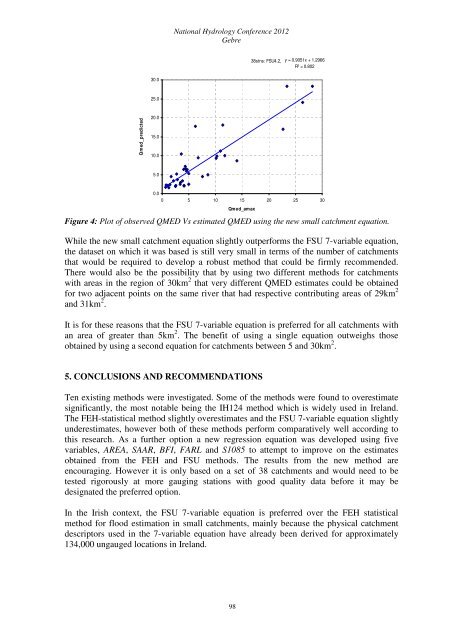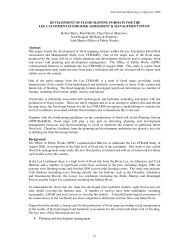09 - flood estimation in small and urbanised catchments in ireland
09 - flood estimation in small and urbanised catchments in ireland
09 - flood estimation in small and urbanised catchments in ireland
You also want an ePaper? Increase the reach of your titles
YUMPU automatically turns print PDFs into web optimized ePapers that Google loves.
National Hydrology Conference 2012<br />
Gebre<br />
38stns: FSU4.2, y = 0.9051x + 1.2966<br />
R 2 = 0.802<br />
30.0<br />
25.0<br />
Qmed_predicted<br />
20.0<br />
15.0<br />
10.0<br />
5.0<br />
0.0<br />
0 5 10 15 20 25 30<br />
Qmed_amax<br />
Figure 4: Plot of observed QMED Vs estimated QMED us<strong>in</strong>g the new <strong>small</strong> catchment equation.<br />
While the new <strong>small</strong> catchment equation slightly outperforms the FSU 7-variable equation,<br />
the dataset on which it was based is still very <strong>small</strong> <strong>in</strong> terms of the number of <strong>catchments</strong><br />
that would be required to develop a robust method that could be firmly recommended.<br />
There would also be the possibility that by us<strong>in</strong>g two different methods for <strong>catchments</strong><br />
with areas <strong>in</strong> the region of 30km 2 that very different QMED estimates could be obta<strong>in</strong>ed<br />
for two adjacent po<strong>in</strong>ts on the same river that had respective contribut<strong>in</strong>g areas of 29km 2<br />
<strong>and</strong> 31km 2 .<br />
It is for these reasons that the FSU 7-variable equation is preferred for all <strong>catchments</strong> with<br />
an area of greater than 5km 2 . The benefit of us<strong>in</strong>g a s<strong>in</strong>gle equation outweighs those<br />
obta<strong>in</strong>ed by us<strong>in</strong>g a second equation for <strong>catchments</strong> between 5 <strong>and</strong> 30km 2 .<br />
5. CONCLUSIONS AND RECOMMENDATIONS<br />
Ten exist<strong>in</strong>g methods were <strong>in</strong>vestigated. Some of the methods were found to overestimate<br />
significantly, the most notable be<strong>in</strong>g the IH124 method which is widely used <strong>in</strong> Irel<strong>and</strong>.<br />
The FEH-statistical method slightly overestimates <strong>and</strong> the FSU 7-variable equation slightly<br />
underestimates, however both of these methods perform comparatively well accord<strong>in</strong>g to<br />
this research. As a further option a new regression equation was developed us<strong>in</strong>g five<br />
variables, AREA, SAAR, BFI, FARL <strong>and</strong> S1085 to attempt to improve on the estimates<br />
obta<strong>in</strong>ed from the FEH <strong>and</strong> FSU methods. The results from the new method are<br />
encourag<strong>in</strong>g. However it is only based on a set of 38 <strong>catchments</strong> <strong>and</strong> would need to be<br />
tested rigorously at more gaug<strong>in</strong>g stations with good quality data before it may be<br />
designated the preferred option.<br />
In the Irish context, the FSU 7-variable equation is preferred over the FEH statistical<br />
method for <strong>flood</strong> <strong>estimation</strong> <strong>in</strong> <strong>small</strong> <strong>catchments</strong>, ma<strong>in</strong>ly because the physical catchment<br />
descriptors used <strong>in</strong> the 7-variable equation have already been derived for approximately<br />
134,000 ungauged locations <strong>in</strong> Irel<strong>and</strong>.<br />
98
















